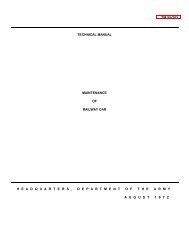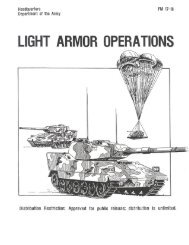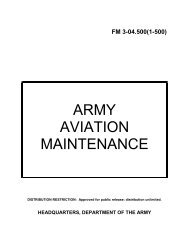AIR DEFENSE ARTILLERY REFERENCE HANDBOOK
AIR DEFENSE ARTILLERY REFERENCE HANDBOOK
AIR DEFENSE ARTILLERY REFERENCE HANDBOOK
You also want an ePaper? Increase the reach of your titles
YUMPU automatically turns print PDFs into web optimized ePapers that Google loves.
Missile Round<br />
FM 44-100-2<br />
railroad car, or Air Force C141 and larger cargo aircraft. Once emplaced, the<br />
battery TOC controls the launchers through a fiber optics link to a LCS.<br />
4-23. Modified PLS Truck. The PLS truck was modified by removing or<br />
relocating some PLS standard equipment, adding rear outriggers, stabilizers,<br />
work platforms, a hydraulic erection system, and a class VI safe for classified<br />
material storage. THAAD equipment installations include an electronics<br />
module, 10 kw generator, wiring harness, electrical motor-driven hydraulic<br />
back-up pump, and a ground rod driver. Two SINCGARS radios are installed<br />
in the cab for voice communications.<br />
4-24. Missile Round Pallet. The missile round pallet is equipped with dual<br />
hydraulic cylinders for elevation purposes. The missile round pallet is used to<br />
support and erect a minimum of eight missiles to the launch elevation angle.<br />
The MRP incorporates an Azimuth Determination Unit (ADU) that provides<br />
azimuth alignment information for the launcher during combat operations<br />
and a missile umbilical junction box that provides truck-to-MRP electrical<br />
interface. The missile round pallet has forklift pockets for ground handling.<br />
4-25. Electronics Module. The electronics elements are incorporated into<br />
the launcher electronics module on the curbside between the cab and the<br />
missile round pallet. The elements include the launch control unit, a<br />
precision lightweight global positioning system receiver, power distribution<br />
unit, and a rechargeable battery. The 10 kw generator recharges the battery<br />
and is mounted on the roadside between the missile round pallet and the<br />
engine on sliding rails to provide maintenance access.<br />
4-26. The THAAD missile round consists of a missile assembly and its<br />
canister. Eight missile rounds are mounted on the missile round pallet. The<br />
missile rounds remain on the pallet through shipment, storage, handling and<br />
loading on the launcher until the missile is fired. Indicators and electrical<br />
connections are located at the aft end of the canister. The indicators allow the<br />
operators to monitor status of the missile round. The electrical connectors are<br />
used to connect the missile to the launcher via the launch module interface<br />
unit.<br />
4-27. Canister. The missile canister weighs 816 pounds, is 261 inches long<br />
and 18.1 inches wide. It provides the means to store, transport, and launch<br />
the missile. It also provides an environment for missile transportation and<br />
can maintain the missile in a ready condition for up to ten years. The canister<br />
is designed to allow access to the missile electronically through an umbilical<br />
cable connection. The canister is made of a filament wound graphite<br />
composite shell.<br />
4-28. Guide pins located at the ends of the canister enable stacking and<br />
assembly on to the missile round pallet. Muzzle and breech closures provide a<br />
seal that protects the interior of the canister from dust, sand, and moisture.<br />
The seals will rupture upon launch and are designed not to cause<br />
interference with the launch or adjacent missile launches from the same<br />
MRP.<br />
4-9











